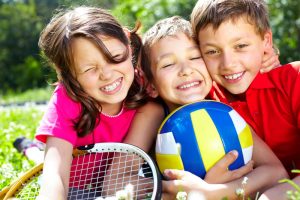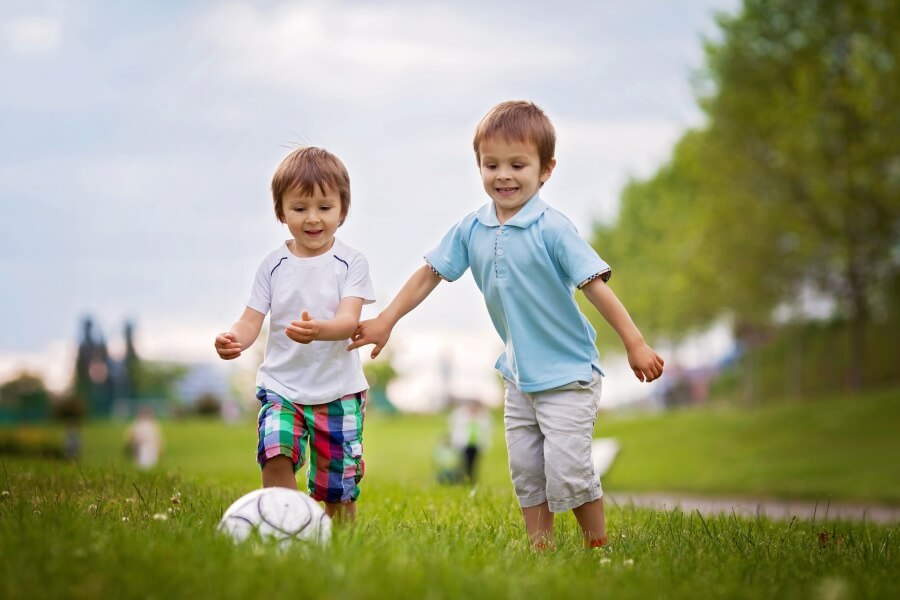6 Activities for Children from the Age of 2 to 5


Reviewed and approved by the psychologist María Alejandra Castro Arbeláez
Kids need to move. Unlike adults, it’s important for them to stay active. There are many different activities for children that can help them improve their motor skills depending on their age.
It’s important to promote activities that help babies develop their fine motors skills and language from the first year of life.
From the age of 2, you can already start to do many different exercises with them. From the age of 5 you can encourage them to practice sports that are a little more difficult.
6 physical activities for your child
Swimming
Swimming is one of the most complete sports that exists. It favors the muscles, respiratory system and the heart.
At the age of two or three the child can already start to attend swimming classes. You’ll have to take certain security measures. This activity should always be supervised by an expert monitor and by the parents as well.
Learning how to swim will help your child lose their fear of water and it will also teach them to relax. In addition, you’ll be opening the door for them to enjoy water activities in the future.
Riding a bike
The child should start with a tricycle at first and then move on to normal bicycles. Cycling is a very functional sport. Its practice, besides being a lot of fun, also stimulates their motor skills.
Riding a tricycle is a good activity for 3-year-old children who have already mastered the art of walking, running and jumping. This means of transport will evolve in size as the child grows.
Like swimming, it’s a sport that suits all ages. You’ll have to pay attention to safety measures.

Throwing or kicking balls
This is an exercise that can be done from the age of 2 and it has the power to fascinate children. This sport uses a lot of energy, since their whole body will be in movement. After the age of five, they can start taking soccer lessons.
Taking soccer lessons can help them develop their speed and endurance. It can also teach them how to work as a team.
I have failed over and over again and that’s why I have achieved success.
Rhythmic or artistic gymnastics
Rhythmic gymnastics is an exercise that a lot of girls like to do, however it can be practiced by both sexes. It allows children to exercise their entire body. It also allows them to develop a sense of rhythm and flexibility.
Rhythmic gymnastics can be practiced from an early age and like any other activity, its difficulty can increase as the child grows and acquires new skills.
Any type of dance
Children can dance very freely. Dance is the perfect activity for an infant. It’s not only a sport, but also an art.
Practicing dance can generate a sense of harmony, rhythm and balance. It can also teach them how to express their emotions.
Dance helps eliminate tension and it will also allow them to meet other children with the same passion for dance.

Some advice for parents
The amount of sporting activities that a 2-year-old child can perform is infinite.
Nothing should deprive them from having rich and positive experiences such as riding a bike, swinging, dancing, running, jumping or doing any other type of activity.
Nowadays, it’s very important to limit routines that call for a sedentary lifestyle. It has been proven that inactivity during childhood can cause many problems during adulthood.
There are many children who suffer from diabetes and obesity due to a poor diet and lack of physical activity.
Children don’t have to practice any sport in particular. It’s simply important for them to be encouraged to move from the moment they learn how to walk.
They can start with easy activities and then increase the complexity according to their age.
Gender is not important in sports. Both boys and girls can practice any kind of sport they like to. Children must be aware of this.
In conclusion, it’s important to know the types of sporting activities to start from childhood. We must create an interesting routine if we want our children to maintain physical activity in adulthood.
Kids need to move. Unlike adults, it’s important for them to stay active. There are many different activities for children that can help them improve their motor skills depending on their age.
It’s important to promote activities that help babies develop their fine motors skills and language from the first year of life.
From the age of 2, you can already start to do many different exercises with them. From the age of 5 you can encourage them to practice sports that are a little more difficult.
6 physical activities for your child
Swimming
Swimming is one of the most complete sports that exists. It favors the muscles, respiratory system and the heart.
At the age of two or three the child can already start to attend swimming classes. You’ll have to take certain security measures. This activity should always be supervised by an expert monitor and by the parents as well.
Learning how to swim will help your child lose their fear of water and it will also teach them to relax. In addition, you’ll be opening the door for them to enjoy water activities in the future.
Riding a bike
The child should start with a tricycle at first and then move on to normal bicycles. Cycling is a very functional sport. Its practice, besides being a lot of fun, also stimulates their motor skills.
Riding a tricycle is a good activity for 3-year-old children who have already mastered the art of walking, running and jumping. This means of transport will evolve in size as the child grows.
Like swimming, it’s a sport that suits all ages. You’ll have to pay attention to safety measures.

Throwing or kicking balls
This is an exercise that can be done from the age of 2 and it has the power to fascinate children. This sport uses a lot of energy, since their whole body will be in movement. After the age of five, they can start taking soccer lessons.
Taking soccer lessons can help them develop their speed and endurance. It can also teach them how to work as a team.
I have failed over and over again and that’s why I have achieved success.
Rhythmic or artistic gymnastics
Rhythmic gymnastics is an exercise that a lot of girls like to do, however it can be practiced by both sexes. It allows children to exercise their entire body. It also allows them to develop a sense of rhythm and flexibility.
Rhythmic gymnastics can be practiced from an early age and like any other activity, its difficulty can increase as the child grows and acquires new skills.
Any type of dance
Children can dance very freely. Dance is the perfect activity for an infant. It’s not only a sport, but also an art.
Practicing dance can generate a sense of harmony, rhythm and balance. It can also teach them how to express their emotions.
Dance helps eliminate tension and it will also allow them to meet other children with the same passion for dance.

Some advice for parents
The amount of sporting activities that a 2-year-old child can perform is infinite.
Nothing should deprive them from having rich and positive experiences such as riding a bike, swinging, dancing, running, jumping or doing any other type of activity.
Nowadays, it’s very important to limit routines that call for a sedentary lifestyle. It has been proven that inactivity during childhood can cause many problems during adulthood.
There are many children who suffer from diabetes and obesity due to a poor diet and lack of physical activity.
Children don’t have to practice any sport in particular. It’s simply important for them to be encouraged to move from the moment they learn how to walk.
They can start with easy activities and then increase the complexity according to their age.
Gender is not important in sports. Both boys and girls can practice any kind of sport they like to. Children must be aware of this.
In conclusion, it’s important to know the types of sporting activities to start from childhood. We must create an interesting routine if we want our children to maintain physical activity in adulthood.
All cited sources were thoroughly reviewed by our team to ensure their quality, reliability, currency, and validity. The bibliography of this article was considered reliable and of academic or scientific accuracy.
- Aguilar-Cordero, M. J., Rodríguez-Blanque, R., Leon-Ríos, X., Expósito Ruiz, M., García García, I., & Sánchez-López, A. M. (2020). Influence of physical activity on blood pressure in children with overweight/obesity: a randomized clinical trial. American Journal of Hypertension, 33(2), 131-136. https://academic.oup.com/ajh/article/33/2/131/5611234?login=false
- CDC. (2022, 12 de enero). Health Benefits of Physical Activity for Children. https://www.cdc.gov/physicalactivity/basics/adults/health-benefits-of-physical-activity-for-children.html
- Gao, Z., Chen, S., Sun, H., Wen, X., & Xiang, P. (2018). Physical Activity in Children’s Health and Cognition. BioMed research international, 2018, 8542403. https://www.ncbi.nlm.nih.gov/pmc/articles/PMC6036844/
- Hoffmann, B., Kobel, S., Wartha, O., Kettner, S., Dreyhaupt, J., & Steinacker, J. M. (2019). High sedentary time in children is not only due to screen media use: A cross-sectional study. BMC pediatrics, 19, 1-9. https://link.springer.com/article/10.1186/s12887-019-1521-8
- Mendieta Toledo, L., Gayrey Atiencia, O., Valverde Ochoa, M. X., & Vargas Mosquera, J. D. (2019). Incidencia del juego de la rayuela en el desarrollo de la psicomotricidad. Espirales Revista Multidisciplinaria De investigación, 3(30). https://www.revistaespirales.com/index.php/es/article/view/612
- Monroy, M. (2003). La danza como juego, el juego como danza. Una pregunta por la pedagogía de la danza en la escuela. Educación y educadores, (6), 159-167.https://revistas.unisabana.edu.co/index.php/eye/article/view/533
- Organización Mundial de la Salud. (2002) Actividad física. Datos y cifras. https://www.who.int/es/news-room/fact-sheets/detail/physical-activity
- Núñez Paredes, F. M. (2023). El juego de la rayuela para el control postural en niños y niñas de 4 a 5 años [Bachelor’s thesis, Carrera de Educación Inicial]. Repositorio Universidad Técnica de Ambato. http://repositorio.uta.edu.ec/handle/123456789/37453
- Rodríguez, C. C. (2011). La importancia de la práctica de la natación en la educación de los niños y las niñas. Lecturas: Educación física y deportes, (161), 8. https://dialnet.unirioja.es/servlet/articulo?codigo=4189891
- Unicef. (s.f.). Prevention of Overweight and Obesity in Children and Adolescents. Consultado el 21 de marzo de 2023. https://www.unicef.org/documents/prevention-overweight-and-obesity-children-and-adolescents
- Vasquez, M. H. T., Ocampo, D. B., Reyes, A. L. J., Sosa, H. I. R., & González, A. G. (2021). Motivos de la inactividad física infantil: Una visión de niños, padres y entrenadores. MHSalud, 18(2), 29-46. https://www.scielo.sa.cr/scielo.php?pid=S1659-097X2021000200029&script=sci_arttext
This text is provided for informational purposes only and does not replace consultation with a professional. If in doubt, consult your specialist.








